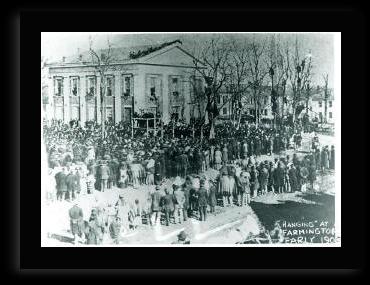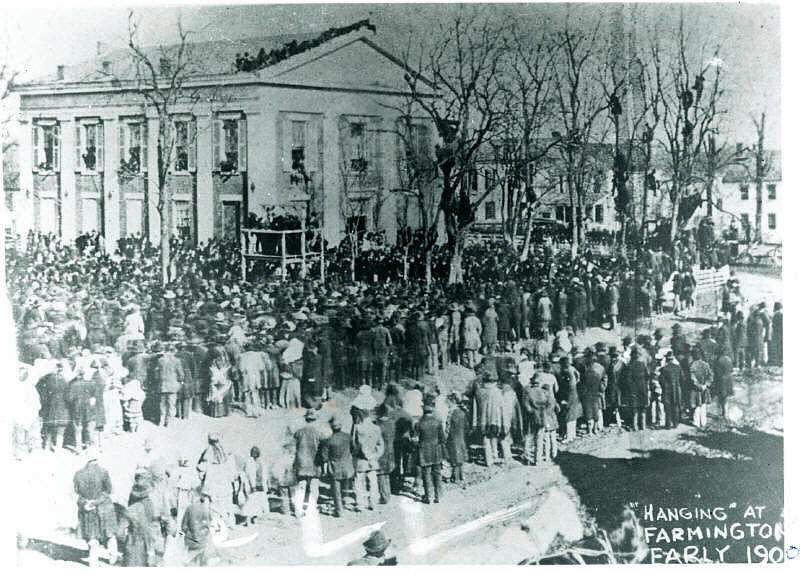
PREVIOUS PAGE

The public hanging of Charles H. Hardin, on the southwest corner of the County Courthouse in Farmington, on January 23, 1880, has been the only legal hanging in St. Francois County since its organization more than 100 years ago.
The execution of Hardin was of such interest that when the appointed day arrived, spectators from as far away as Ripley, Bollinger, and Pemiscot counties began to arrive until by noon, on Friday, January 23, 1880, there were between 4,000 and 5,000 persons gathered in Farmington to witness the gruesome event.
Speculation had run high as to whether Hardin would make a public confession of the crime for which he had been sentenced to pay the supreme penalty. At 1 p.m. on this day, he was taken from the County Jail, and carried by means of a spring wagon drawn by a team of horses to a spot where the scaffolds had been arranged by Messers. Lang and Brothers.
With him rode his attorney, Jasper M. Burk, reporters from several daily newspapers, Major Thornbug, from Bollinger County, who had been summoned by Sheriff McMullin to adjust the ropes, and Reverend D. H. Parker, Hardin's spiritual advisor.
As they arrived at the location of the scaffold, Hardin climbed the steps slowly. He was dressed in a plaid business suit, a spotless shirt front, and a cravate. He knelt down to pray with Reverend Parker, then got up to talk to the crowd.
A portion of his last utterances were: "My sentence is a hard one, but it is just. I have nothing to say against the judge or the jury, or against Mr. Carter. He is a perfect gentleman. But I do think some of the witnesses didn't do me justice, but I forgive them all. The people have treated me kindly, and a good deal better than I had any reason to expect."
The large crowd was not disappointed that Hardin didn't make a public confession, but instead gave a religious oration in telling others not to follow in his footsteps.
As he was led to the trap, he said "Farewell vain world. This is the way Jesus supports a man in my condition."
Five physicians were on hand to pronounce Hardin's death. It was discovered that he had come to his death not as a result of a broken neck, but as a result of strangulation.
The GLOBE DEMOCRAT at the time created the idea that it was a cruelly managed affair. This had little foundation, for the victim suffered little. His remains were placed in the County Graveyard. The scaffold was returned to Messers. Lang and Brothers, where it remained for some time, after which it was taken apart.
The site of Hardin's crime was a camping site on Indian Creek, near the village of Haggai, situation three miles southeast of Iron Mountain.
The time was October, 1879. Robert Ferguson, from his home in Kansas, was enroute to Illinois, where relatives of his lived. With him was five-year-old son, John. He was travelling in a common wagon drawn by a team of horses.
Several days before reaching the fatal site, Mr. Ferguson was joined by Charles H. Hardin, who was also driving a span of horses which he had borrowed from a Mrs. Best, in Sedalia, Missouri.
On Sunday, October 26th, 1879, they came to the above mentioned location. Mr. Ferguson had with him when he left Kansas $350. Mr. Hardin wanted this money, and this is the way he managed to get it.
After the evening meal, Mr. Ferguson was sitting on a stool before the campfire. When Hardin picked up a stick, as if to stir the fire, he turned suddenly and struck Ferguson with it. Several such licks crushed his skull, and he soon died. The body was partly submerged in a stream where it was discovered two days later by the children of some campers.
In the meantime, Hardin had taken the small boy, the plunder, one wagon, and the four horses, and escaped by a train to Columbus, Kentucky, after which he was brought back to Farmington to stand trial.
A letter found on the body of Ferguson led to his identity, and a card was found showing he had been an Oddfellow in Franklin County, Illinois, so his body was buried in the Oddfellow's cemetery in Farmington.
On Tuesday, December 2nd, 1879, Charles H. Hardin was brought before Judge Nicholson for trial. This important hearing was conducted in the old Lang building, since the courthouse was condemned at this time.
The attorneys for the state were Prosecuting Attorney Francis M. Carter, the Hon. J. F. Bush, and Merril Pipkin. The lawyers for the defendant were Messers. Jasper M. Burks, and J. W. Bennick.
In several days, the testimony was completed, and the jury, after 20 minutes, gave the verdict of guilty. The execution of Charles Hardin was the only legal hanging in this county, but on June 14th, 1843, James Layton was hung from a beam just south of the County Jail by an angry mob who stormed the jail, and removed Layton by force.
